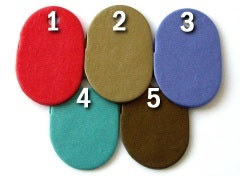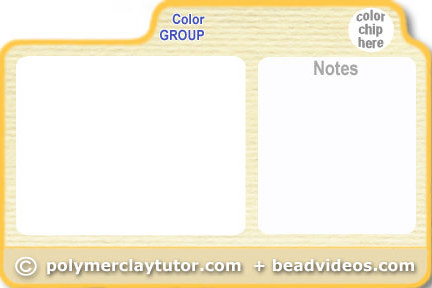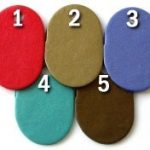
Kato Polyclay Color Recipes | Rich Metallics Palette [Sue-F]
(1) Scarlet Satin; (Pearl); (2) Basically Brass (Mtl); (3) Indigo Ice (Pearl); (4) Persian Green (Pearl); (5) Bronze (Metallic)
More...
Today’s post is for all the Kato Clayer’s that read this blog. Sue Fisher, who lives in Australia, has sent in another one of her Kato Polyclay color palettes. She calls this one, Rich Metallics.
sue f
Here’s another original Kato colour palette for you, called Rich Metallics. I wanted to use pearlised or metallic colours this time to tie in with your recent Blend and Switch technique, but I had a hard time avoiding colours with Kato concentrates! In the end I chose a palette with one colour that needs them.
The red in this palette cannot be mixed as a pearlised colour in Kato without the use of Red Concentrate, so if anyone who doesn’t have Red Concentrate wants to use a red with the other colours I’d suggest plain Red straight out of the packet. It will be very close to the intended colour, just not pearlescent. The other four colours are mixed with ordinary Kato and look nice on their own too, so another option is to drop the red for a four-colour palette that is more sophisticated but less bold. (The best option is to get the concentrates, however… they are wonderful!)
SF-003-1 Scarlet Satin (Pearl)
- 1 part Red Concentrate (Kato)
- 2 parts Orange (Kato)
- 1 part Pearl (Kato)
SF-003-2 Basically Brass (Metallic)
- 5 parts Gold (Kato)
- 1 part Turquoise (Kato)
- 2 parts Black (Kato)
- 6 parts Pearl (Kato)
SF-003-3 Indigo Ice (Pearl)
- 2 parts Blue (Kato)
- 8 parts Violet (Kato)
- 5 parts Pearl (Kato)
SF-003-4 Persian Green (Pearl)
- 2 parts Turqoise (Kato)
- 1 part Green (Kato)
- 2 parts Pearl (Kato)
SF-003-5 Bronze (Metallic)
- 1 part Gold (Kato)
- 2 parts Black (Kato)

To download a blank recipe card that can be duplicated and used for keeping your collection organized, click on the following link: Polymer Clay Recipe Card
If you like receiving these Kato color recipes, be sure to let Sue know in the comments section below. It takes a lot of time and energy to create polymer clay color palettes. So I would like to say thank you very much, Sue, for sharing your work with everyone.
** Index of Previously Posted Guest Color Palettes:
2009-07-10: Eleven Sculpey III Color Recipes [Carrie-W]
2009-08-02: Six Sculpey III Color Recipes [Carrie-W]
2010-02-07: Kato Polyclay Color Recipe | Pansy Flower Palette [Sue-F]
2010-02-13: Kato Polyclay Color Recipes | Spice and Serenity [Sue-F]
2010-02-27: Kato Polyclay Color Recipes | Blue Hosta Palette [Sue-F]
2010-03-10: Kato Polyclay Color Recipes | Alpine Succulent [Sue-F]
2010-04-19: Kato Polyclay Color Recipes | Bouquet of Violets [Sue-F]
2010-09-05: Kato Polyclay Color Recipes | Rich Metallics [Sue-F]
Sponsored Ads & Special Promotions


Want to chat about today’s post? That’s what the comment section below is for. Scroll Down… We’d love to hear from you!
Or... if you would like to request a topic for a future post, here is the link to do that… PcT Suggestion Box

I know how to do soldering when doing stained glass but would love to learn how to solder jewelry. I’ve heard of something called ‘cold soldering’ when doing metal smithing. I’d love a tutorial Cindy.
Thanks Sue so kind of you to share these.
I have just started using the concentrates too after having used them in some workshops. A tip I got from a friend on a workshop when using concentrates to colour translucent clay was to mix the colour you wanted with the concentrates before mixing into the translucent. It was a lot easier to control it that was particularly as we only really wanted a tint and i kept on adding more and more colour trying to get it right.
Thank-You Sue for the awesome colors.
Thanks Sue for the great Kato colour recipes. I have been using Kato more and more for buttons as I prefer its durability. I get the concentrates from Shades of Clay here in Canada.
Thanks for this new colors!
What an awesome resource for Kato users…thanks, Sue!
@Sue F: The darker one is the one I used this time… But I will probably find a use for the lighter one too. Thanks again!
Ooo, I love to shop at Prarie Craft for clay stuffs!! I’m hoping my cutters arrive Friday! I’ve got an Art Clay Sheet just waiting to go.
~Lisa :)
@Sue F- I’ve seen their pyramid forms but have no ideas in my pea brain as to what they would be used for. Any brain expansion would be appreciated!
Thanks everyone! :)
@Lisa: I’m glad they worked! Out of curiosity, which was closer to the kind of denim blue you had in mind? (And PrairieCraft have some really neat stuff, don’t they? I have to get some of those pyramid forms, myself!)
I also would like to thank you Sue. I like using kato for canes. I have seen the concentrates and know what they are just haven’t tried them yet. Now that you are sharing more recipes with us and beautiful colors they are, you are inspiring me to try more colors in Kato. So now concentrate will go on my shopping list so I can give them a try.
Clayfully yours, Peggy
Thanks Sue F.!!!!! Now I’ll have to wait until I have another order at Prairie Craft to get my concentrates… *grin* I just ordered a bunch of cutters from them.
Oh, and the recipes you shared with me for Denim worked out great, thanks again – you were a great help!!
Clay On,
~Lisa :)
It’s so nice of you to share these, Sue. I don’t use Kato clay and who knows if I ever will…but if I do, I know these recipes are here!
@Linda K.: Sue. Thank you so much! As a convert to Kato Clay, I really appreciate these recipes.
@Carolyn: I’ve heard Kato Concentrates being described as “food colouring for polymer clay”. They’re basically super-concentrated colours that are not meant for use on their own, but for mixing with standard polymer clay when you want intense colour.
They’re also slightly different in colour to the regular Kato clays. For example, Kato Red Concentrate is a “bluer” red than regular Kato Red clay (the Scarlet Satin recipe is a bit of an indication of that: it’s very close to being a pearlescent version of standard Kato Red, but to make it I need both Red Concentrate and standard Orange. As well as Pearl, obviously! ;D). Kato Green Concentrate is darker and bluer than standard Kato Green. Kato Blue Concentrate is darker and slightly more purple than standard Kato Blue. And Kato Yellow Concentrate looks like a slightly richer version of standard Kato Yellow.
Kato Concentrates are not sold in individual colours. They come in a 4oz four-pack consisting of 1oz each of Blue Concentrate, Red Concentrate, Yellow Concentrate and Green Concentrate.
I didn’t have them until relatively recently, but as soon as I started using them I totally fell in love with them. They’re wonderful for mixing rich pearlescent colours, for tinting translucent without noticeable reducing transparency, and when you want very saturated colour (some of my favourite non-pearlescent reds can’t be mixed without Red Concentrate, for example).
Thanks so much, Sue. I’m not even sure what the concentrates are … are they liquid? … or just a very strong clay? … or what? It is great that you did this one with Cindy’s Blend & Switch in mind. I just love that process and look forward to making it with Kato … once I get back home. I didn’t bring my Kato clays with me.
Cindy, thank you for allowing Sue to share these recipes here on your blog. This type of sharing just reinforces what your blog is all about … learning and sharing … and caring along the way.
Thanks, Sue, looking forward to trying these in the future.